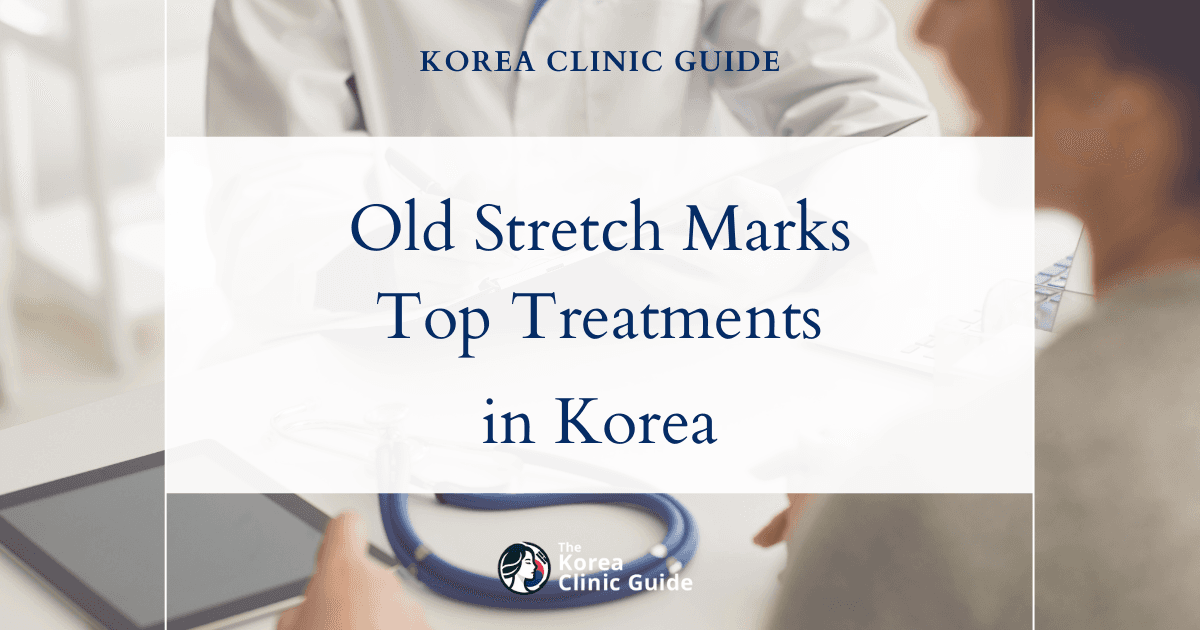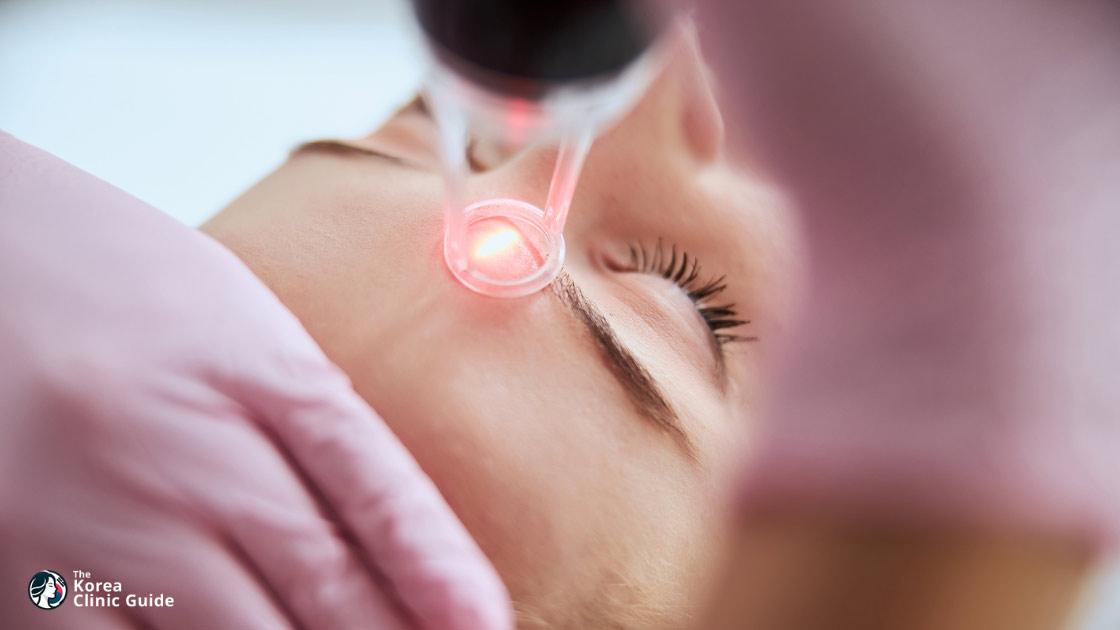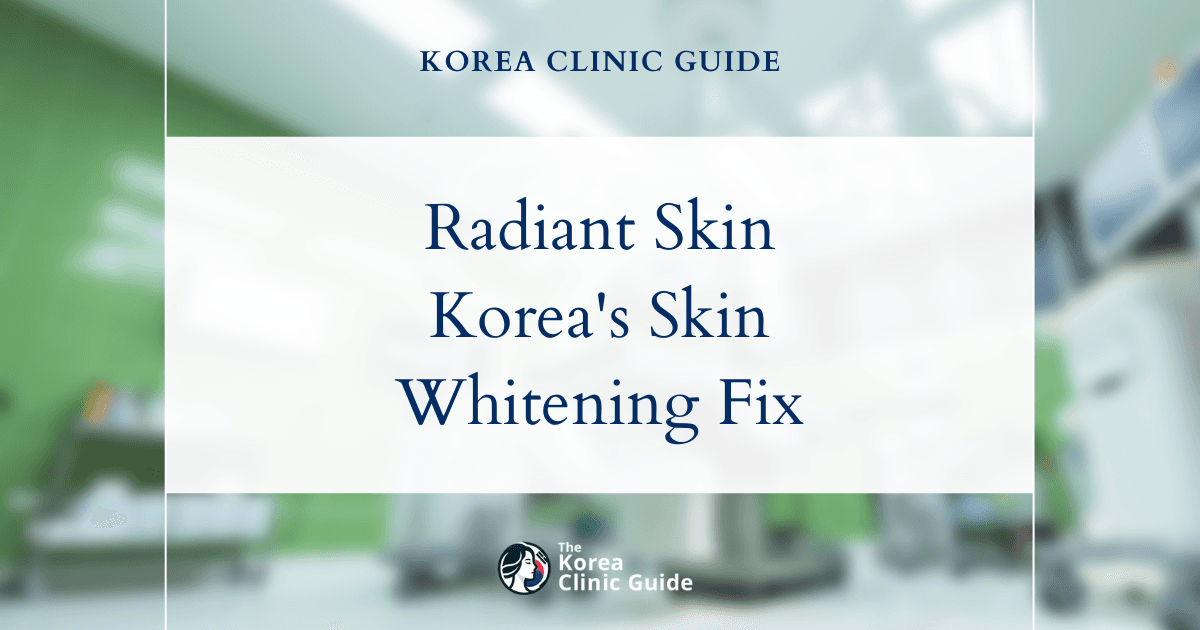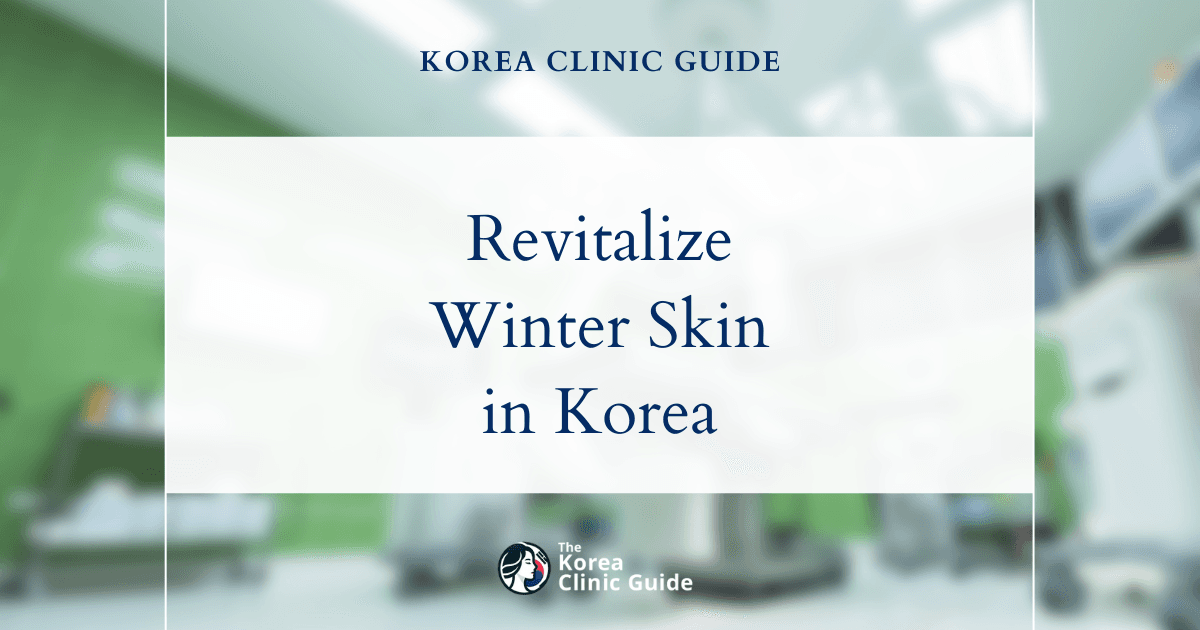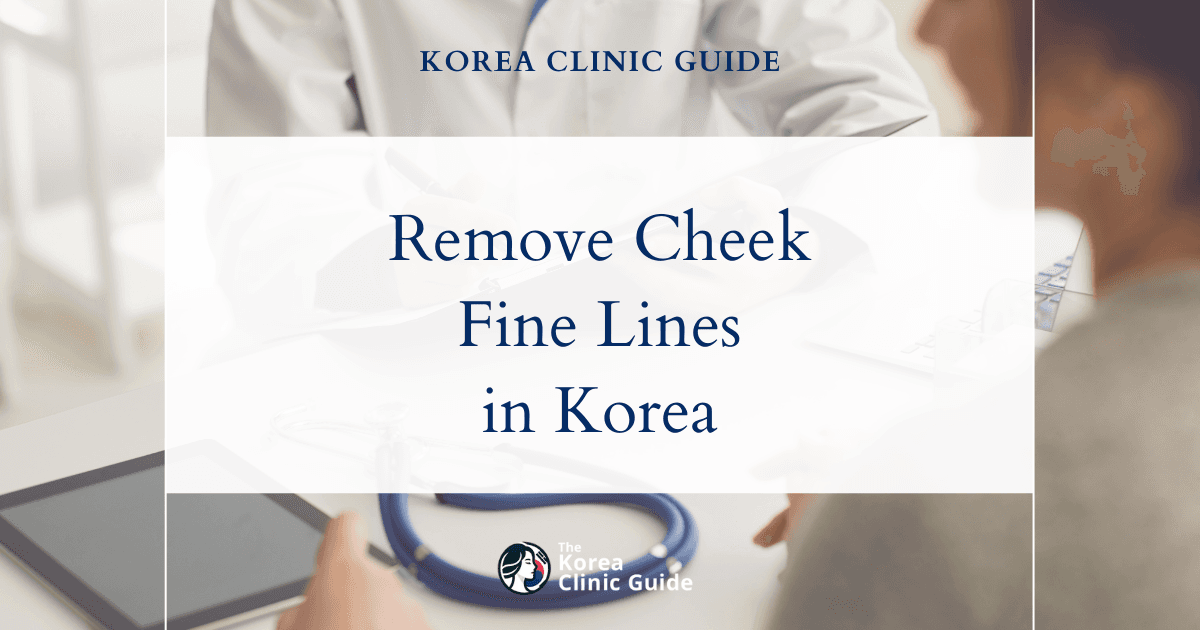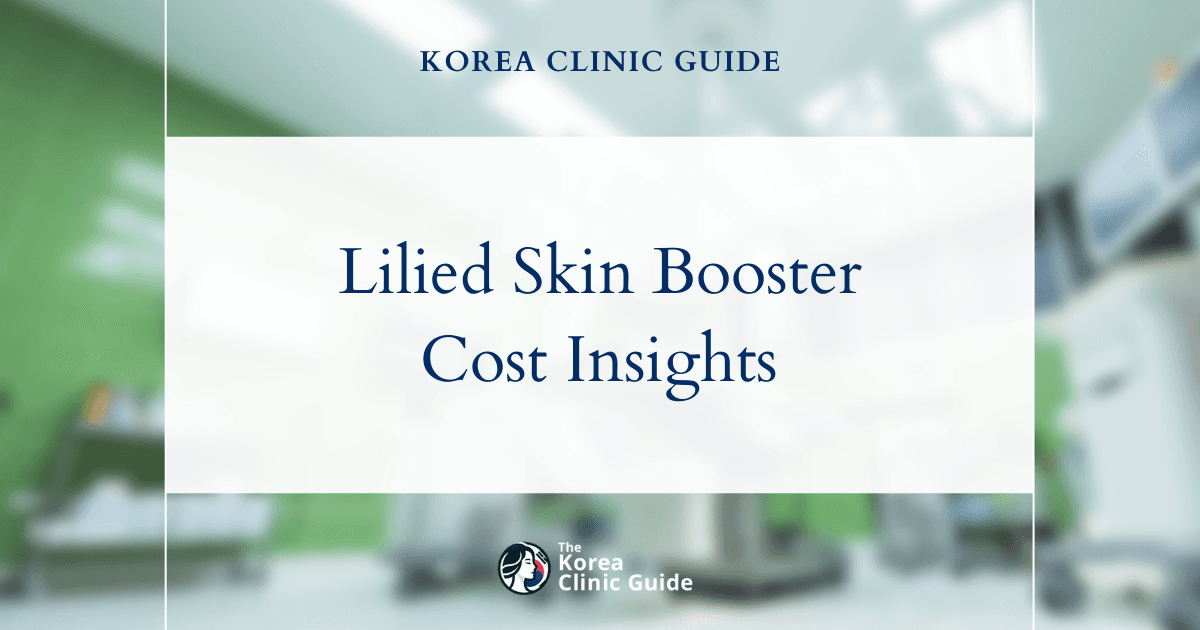Medical Tourism Blog
Pigmentation Treatment in Korea | Best Clinics, Costs, Procedure Types & More
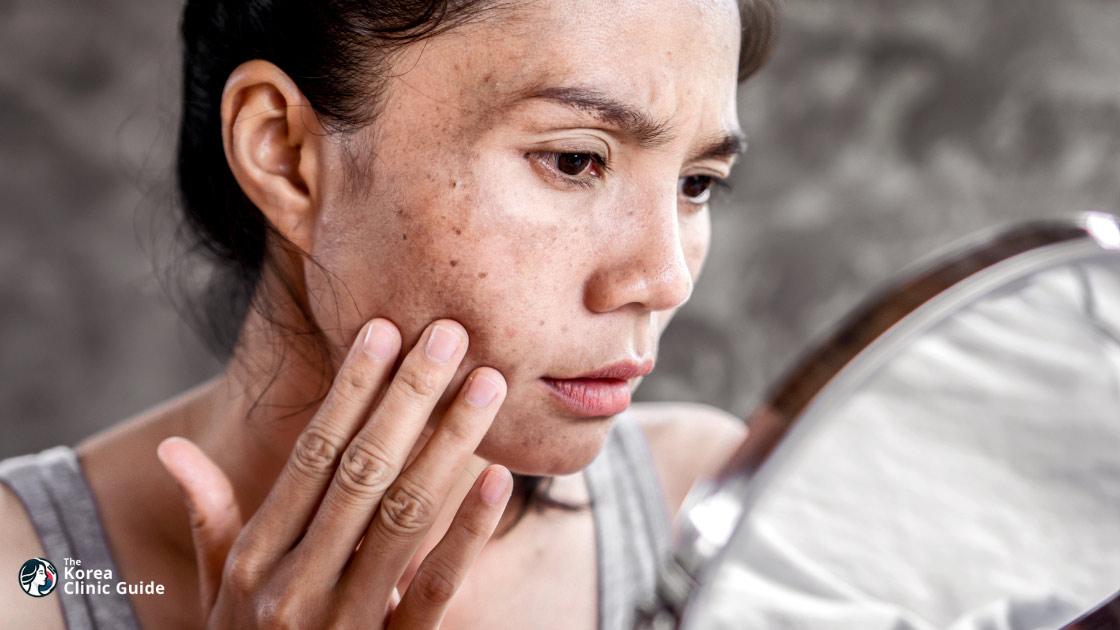
Table of contents
Considering treatment in Korea? Everything you need to know e.g. — how to avoid scams, visas, interpreters, recovery tips — in our Medical Tourism Master Guide. Plan with confidence in minutes, not weeks!
Have you ever wondered why Korea is leading the charge in skin pigmentation treatments? With groundbreaking advancements in technology and a wealth of expertise in aesthetic medicine, Korea is setting new standards for effective and personalized skincare solutions. This article explores the depth of pigmentation treatments available in Korea, identifying the latest procedures and top clinics, while providing invaluable insights into the costs and care required for optimal results.
Pigmentation Treatment Overview
Pigmentation treatment refers to a range of dermatological procedures and therapies aimed at reducing or eliminating skin discoloration, which can manifest as dark spots, patches, or uneven skin tone. Pigmentation disorders often result from an overproduction of melanin, the pigment responsible for the color of our skin, hair, and eyes. Common causes include sun exposure, hormonal changes, aging, genetic factors, and inflammation or injury to the skin. Pigmentation treatment can address various conditions such as melasma, post-inflammatory hyperpigmentation, age spots (also known as liver spots), and freckles.
Types of Pigmentation Disorders
- Melasma: Typically presents as brown or gray-brown patches, usually on the face. It is more common in women and is often linked to hormonal changes.
- Post-inflammatory Hyperpigmentation (PIH): Occurs following an injury or inflammation to the skin, such as acne, burns, or eczema.
- Age Spots (Solar Lentigines): Flat, brown spots commonly found on sun-exposed areas such as the face, hands, and arms, primarily affecting older individuals.
- Freckles (Ephelides): Small, flat spots that increase in number and darkness with sun exposure, often appearing during childhood.
Treatment Modalities
-
Topical Treatments:
- Lightening Agents: Include hydroquinone, azelaic acid, kojic acid, and retinoids. These ingredients work by inhibiting melanin production or accelerating skin cell turnover to fade dark spots.
- Exfoliants: AHAs (alpha hydroxy acids) and BHAs (beta hydroxy acids) help to remove the outermost layer of dead skin cells, improving skin tone.
-
Chemical Peels: Use acids like glycolic acid, trichloroacetic acid (TCA), or salicylic acid to exfoliate and rejuvenate the skin, promoting cell turnover and reducing pigmentation.
-
Laser Therapy:
- Ablative Lasers: Such as CO₂ and Erbium lasers, remove the outer layers of the skin, which can be effective for deeper pigmentation issues.
- Non-Ablative Lasers: Including Q-switched Nd:YAG and fractional lasers, target deeper layers of the skin without removing the top layers, suitable for treating various types of pigmentation.
-
Intense Pulsed Light (IPL): Uses broad-spectrum light to target and break down melanin, improving pigmentation and overall skin tone.
-
Microdermabrasion: A minimally invasive procedure that uses tiny exfoliating crystals to remove the outermost layer of skin, helping to fade pigmentation spots.
Considerations for Treatment
- Skin Type: Fitzpatrick skin types I to III (lighter skin tones) generally respond better to many pigmentation treatments, while darker skin types (IV to VI) require more cautious approaches to avoid potential side effects like hypopigmentation or hyperpigmentation.
- Sun Protection: Essential before, during, and after treatment to prevent further pigmentation and protect treated skin.
- Maintenance: Some treatments may require multiple sessions to achieve desired results and ongoing maintenance to keep pigmentation at bay.
Treatments should be personalized based on the individual's specific type of pigmentation, skin type, and overall skin health. Consulting with a qualified dermatologist or skincare professional is crucial for developing an effective treatment plan.
Pigmentation Treatment Procedure
Pigmentation treatment in Korea, known for its advanced skincare and cosmetic procedures, involves several steps to ensure effective and personalized care. Here's a typical procedure:
1. Initial Consultation
Before any treatment begins, patients undergo an initial consultation with a dermatologist. This step includes a thorough skin analysis and discussion of medical history to identify the type and cause of pigmentation. The dermatologist will assess the severity of the condition and recommend suitable treatment options.
2. Customized Treatment Plan
Based on the consultation, a customized treatment plan is developed. This plan may include one or more of the following procedures:
-
Chemical Peels
Chemical peels use a solution to remove the outer layer of skin, promoting collagen production and the growth of new, even-toned skin. The strength and type of peel depend on the pigmentation severity. -
Laser Treatments
Laser therapy targets melanin in the skin with high-intensity light. This breaks down pigmentation and stimulates collagen production, resulting in smoother and more even skin. -
Microdermabrasion
This non-invasive procedure uses a device to exfoliate the skin gently. It removes dead skin cells and stimulates new cell growth, helping to reduce pigmentation and improve skin texture. -
Intense Pulsed Light (IPL)
IPL therapy uses broad-spectrum light to target pigmented cells without damaging surrounding tissue. It’s effective for treating areas with sun spots, age spots, and other pigmentation issues.
3. Pre-Treatment Preparation
Patients may need to follow specific pre-treatment instructions, such as avoiding sun exposure, discontinuing certain skincare products, and using prescribed topical medications to prepare the skin.
4. The Treatment Session
During the treatment session, the procedure is performed according to the customized plan:
- Chemical Peels: The chemical solution is applied to the skin and left for a specific period.
- Laser Treatments: A laser device is used to treat pigmented areas.
- Microdermabrasion: The device is moved across the skin to exfoliate.
- IPL: The IPL device is moved over the skin, emitting pulses of light.
Sessions typically last between 30 minutes to an hour, depending on the treatment type and area being treated.
5. Post-Treatment Care
Proper aftercare is crucial for optimal results. Patients are given specific instructions that may include:
- Avoiding direct sunlight and using sunscreen regularly.
- Applying prescribed topical treatments to aid healing and reduce the risk of hyperpigmentation recurrence.
- Following a gentle skincare routine to maintain improvements.
6. Follow-Up Visits
Regular follow-up visits are scheduled to monitor progress and make necessary adjustments to the treatment plan. This ensures long-term success and addresses any concerns the patient may have.
7. Maintenance Treatments
To maintain results, periodic maintenance treatments may be recommended. These could involve less intensive procedures or continued use of specific skincare products.
Through this comprehensive process, Korea’s advanced pigmentation treatment aims to deliver effective and lasting improvements, tailored to each individual's skin type and concerns.
Who is Pigmentation Treatment for?
-
Individuals with Age Spots:
- Commonly known as liver spots, these are a prevalent form of hyperpigmentation.
-
People with Melasma:
- Characterized by gray-brown patches, often resulting from sun exposure.
-
Patients on Certain Medications:
- Some drugs, including chemotherapy treatments, can cause skin darkening.
-
Pregnant Women:
- Hormonal changes during pregnancy can lead to skin pigmentation issues.
-
Persons with Endocrine Diseases:
- Conditions like Addison’s disease can affect skin pigmentation.
-
Individuals with Insulin Resistance:
- These metabolic issues can contribute to pigmentation changes.
-
People with Skin Trauma or Irritation:
- Trauma or irritation from various sources can cause hyperpigmentation.
-
Anyone Experiencing Cosmetic Concerns:
- Although often harmless and cosmetic in nature, hyperpigmentation treatments can be sought for aesthetic reasons.
Best Clinics in Korea for Pigmentation Treatment
Listed below are the best clinics in Korea for pigmentation treatment:
| Clinic Name | Key Features | Special Techniques |
|---|---|---|
| ID Hospital - Sinsa | For those seeking clear, even-toned skin in Korea, ID Hospital in Sinsa stands out as the best choice for pigmentation treatment because it combines targeted brightening lasers with comprehensive skin-rejuvenation and fully personalized planning. Its dedicated pigmentation technologies—Pico Toning to precisely break down sun spots, age spots, and other hyperpigmentation for a brighter, more uniform complexion, and the Excel V Laser to reduce vascular-related discoloration such as redness, visible veins, and stubborn spots—allow the clinic to address both melanin and vascular components of uneven tone for more complete results. To support clearer skin that looks healthy and luminous, ID pairs these lasers with advanced boosters like Exosome Boosters, Rejuran Healer, and Juvelook, which improve texture, elasticity, and hydration so improvements in pigmentation are complemented by refined, resilient skin quality. Guided by the ID Premium Elanse consultation, treatment plans are customized to individual pigment patterns, skin needs, and aesthetic goals, ensuring natural-looking outcomes delivered with the precision and care that define ID Hospital’s extensive aesthetic expertise in Sinsa. | Pico Toning; Excel V Laser; Exosome Boosters; Rejuran Healer; Juvelook; ID Premium Elanse consultation |
| Modelo Clinic | In Korea, Modelo Clinic approaches pigmentation treatment with a philosophy that does not follow trends but instead seeks beauty that maximizes your values over time. Centered on your beautiful individuality, the clinic designs measured, personalized care plans that respect your unique features and skin biology, prioritizing natural harmony over one-size-fits-all solutions. Modelo’s Whitening program targets freckles, blemishes, and melasma using various laser and combination treatments tailored to your skin tone, sensitivity, and pattern of discoloration. To enhance overall brightness and balance, care can be complemented by options like Baby Filler to address under-eye hollows that accentuate dark circles, or lifting modalities to refine skin quality—always with comfort, gradual improvement, and natural-looking results in mind. Guided by experience with Asian skin characteristics and a commitment to long-term outcomes, Modelo Clinic delivers pigmentation care that elevates clarity while honoring your individuality. | Philosophy of individuality with measured, personalized care plans; Whitening program targets freckles, blemishes, and melasma using various laser and combination treatments tailored to skin tone, sensitivity, and pattern of discoloration; care can be complemented by Baby Filler for under-eye hollows and lifting modalities to refine skin quality. |
| Rose City Clinic | Rose City Clinic at Konkuk University is a comprehensive aesthetic center offering a full spectrum of face and body treatments designed to enhance your natural beauty, with particular strength in pigmentation care through targeted procedures that improve skin clarity, tone, and texture. - Dedicated pigmentation solutions: Toning treats uneven skin tone and pigmentation, while Clarity Procedures focus on advanced hyperpigmentation and texture concerns for a brighter, clearer complexion. - Post-acne discoloration care: Scar and Blemish Removal targets acne scars and marks, and Acne Treatment provides comprehensive care for active breakouts and post-acne marks—key for managing pigment issues over time. - Personalized maintenance: Skin Care Programs deliver customized regimens—including facials and peels—to sustain and refine results for long-term clarity. - Radiance and texture support: Skin Booster micro-injections improve hydration, elasticity, and overall radiance, helping skin look smoother and more even. - Skin health optimization: LDM (Local Dynamic Micromassage) enhances skin health and elasticity, supporting balanced tone and improved skin vitality alongside pigmentation care. - Comprehensive, coordinated care under one roof: From consultation to follow-up, the clinic’s broad portfolio (including lifting and contouring technologies like Shurink and InMode) allows tailored, multi-modal plans that complement complexion goals. - Accessible and trusted: Located at Konkuk University with online consultations and patient reviews available for added convenience and confidence in your treatment journey. | Toning; Clarity Procedures; Scar and Blemish Removal; Acne Treatment; Skin Care Programs; Skin Booster micro-injections; LDM (Local Dynamic Micromassage); Shurink; InMode |
ID Hospital - Sinsa
For those seeking clear, even-toned skin in Korea, ID Hospital in Sinsa stands out as the best choice for pigmentation treatment because it combines targeted brightening lasers with comprehensive skin-rejuvenation and fully personalized planning. Its dedicated pigmentation technologies—Pico Toning to precisely break down sun spots, age spots, and other hyperpigmentation for a brighter, more uniform complexion, and the Excel V Laser to reduce vascular-related discoloration such as redness, visible veins, and stubborn spots—allow the clinic to address both melanin and vascular components of uneven tone for more complete results. To support clearer skin that looks healthy and luminous, ID pairs these lasers with advanced boosters like Exosome Boosters, Rejuran Healer, and Juvelook, which improve texture, elasticity, and hydration so improvements in pigmentation are complemented by refined, resilient skin quality. Guided by the ID Premium Elanse consultation, treatment plans are customized to individual pigment patterns, skin needs, and aesthetic goals, ensuring natural-looking outcomes delivered with the precision and care that define ID Hospital’s extensive aesthetic expertise in Sinsa.
Find more about this clinic here: ID Hospital - Sinsa Website
Modelo clinic
In Korea, Modelo Clinic approaches pigmentation treatment with a philosophy that does not follow trends but instead seeks beauty that maximizes your values over time. Centered on your beautiful individuality, the clinic designs measured, personalized care plans that respect your unique features and skin biology, prioritizing natural harmony over one-size-fits-all solutions.
Modelo’s Whitening program targets freckles, blemishes, and melasma using various laser and combination treatments tailored to your skin tone, sensitivity, and pattern of discoloration. To enhance overall brightness and balance, care can be complemented by options like Baby Filler to address under-eye hollows that accentuate dark circles, or lifting modalities to refine skin quality—always with comfort, gradual improvement, and natural-looking results in mind. Guided by experience with Asian skin characteristics and a commitment to long-term outcomes, Modelo Clinic delivers pigmentation care that elevates clarity while honoring your individuality.
Find more about this clinic here: Modelo clinic Website
Rose City Clinic
Rose City Clinic at Konkuk University is a comprehensive aesthetic center offering a full spectrum of face and body treatments designed to enhance your natural beauty, with particular strength in pigmentation care through targeted procedures that improve skin clarity, tone, and texture.
- Dedicated pigmentation solutions: Toning treats uneven skin tone and pigmentation, while Clarity Procedures focus on advanced hyperpigmentation and texture concerns for a brighter, clearer complexion.
- Post-acne discoloration care: Scar and Blemish Removal targets acne scars and marks, and Acne Treatment provides comprehensive care for active breakouts and post-acne marks—key for managing pigment issues over time.
- Personalized maintenance: Skin Care Programs deliver customized regimens—including facials and peels—to sustain and refine results for long-term clarity.
- Radiance and texture support: Skin Booster micro-injections improve hydration, elasticity, and overall radiance, helping skin look smoother and more even.
- Skin health optimization: LDM (Local Dynamic Micromassage) enhances skin health and elasticity, supporting balanced tone and improved skin vitality alongside pigmentation care.
- Comprehensive, coordinated care under one roof: From consultation to follow-up, the clinic’s broad portfolio (including lifting and contouring technologies like Shurink and InMode) allows tailored, multi-modal plans that complement complexion goals.
- Accessible and trusted: Located at Konkuk University with online consultations and patient reviews available for added convenience and confidence in your treatment journey.
Find more about this clinic here: Rose City Clinic Website
Benefits of Pigmentation Treatment in Korea
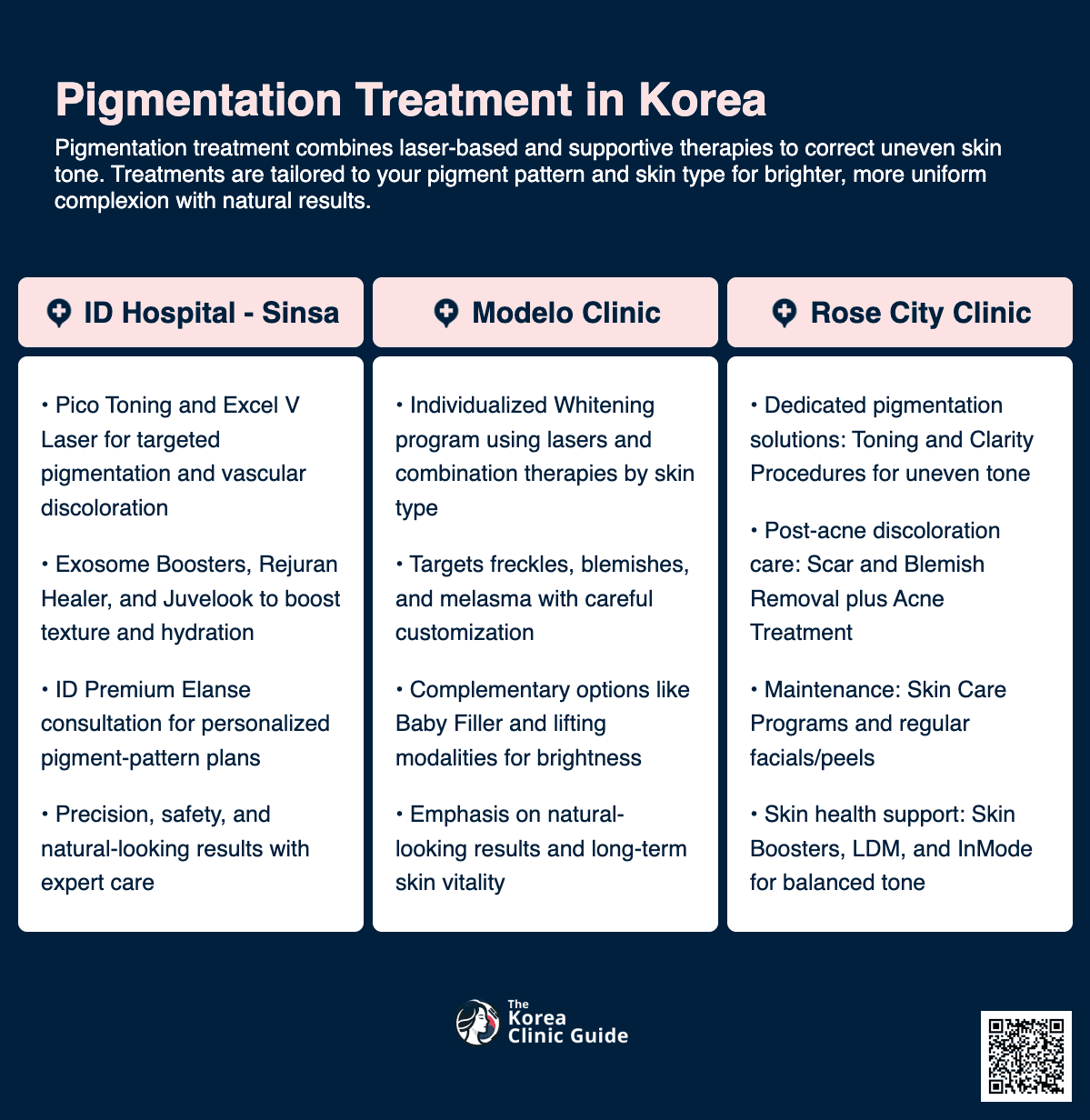
Korea is renowned for its advanced skincare treatments and innovative technologies. Here are some of the key benefits of getting pigmentation treatment in Korea:
Advanced Technology
Korea is at the forefront of skincare innovation, utilizing state-of-the-art technology for pigmentation treatments. Clinics are equipped with the latest laser devices, such as the Q-switched Nd:YAG laser and Picosecond lasers, which offer precise targeting of pigmented lesions and minimize damage to surrounding skin tissue.
Highly Skilled Professionals
Korean dermatologists and skincare specialists are highly trained and often receive extensive education and hands-on practice in pigmentation treatments. Many dermatologists in Korea have international training and are up-to-date with the latest research and trends in the field.
Customized Treatment Plans
Patients in Korea benefit from personalized treatment plans tailored to their specific skin type and condition. Dermatologists take into account various factors like the severity of pigmentation, skin sensitivity, and personal treatment goals to design effective and individualized treatment strategies.
Comprehensive Approaches
Pigmentation treatment in Korea often includes a comprehensive approach that combines different types of treatments for optimal results. This might involve a mixture of laser treatments, topical ointments, and oral medications for a holistic approach to reducing pigmentation issues.
Enhanced Aftercare
Post-treatment care is crucial for the success of pigmentation treatments. Korean clinics offer exceptional aftercare services, including follow-up visits and detailed skincare regimens to ensure that the skin heals properly and that the results are long-lasting.
Quick Recovery Time
With the advanced technologies and techniques used in Korea, recovery times are often shorter compared to traditional methods. Minimally invasive procedures mean that patients can return to their regular activities more quickly without prolonged downtime.
Aesthetic Results
Korean pigmentation treatments are renowned for delivering natural and aesthetically pleasing results. The treatments are designed to enhance the skin's overall appearance, giving it a smoother, more even tone without the risk of unsightly marks or scars.
Competitive Pricing
Despite the high quality of care and advanced technology, the cost of pigmentation treatments in Korea is often more affordable than in many Western countries. Patients receive top-notch care without breaking the bank, making Korea an attractive destination for medical tourism.
Cultural Expertise
Korean experts in skincare have in-depth knowledge of Asian skin types, which often experience specific pigmentation issues different from those of other ethnicities. This specialized expertise translates into more effective treatment outcomes for many international patients as well.
Cost of Pigmentation Treatment in Korea
When considering pigmentation treatment, cost is a major factor for many patients. In Korea, the cost of pigmentation treatment—whether you are dealing with melasma, age spots, or other skin discolorations—typically ranges from $150 to $500 per session. The total cost will depend on the number of sessions required and the specific type of treatment used, such as laser therapy, chemical peels, or topical medications.
Comparatively, the cost of pigmentation treatment in the USA is significantly higher. In the United States, the average cost can range from $300 to $1,000 per session. Similar to Korea, the total expense will vary based on the number of sessions needed and the specific treatments chosen.
Given this substantial difference, medical tourism to Korea for pigmentation treatment can be economically advantageous. Not only are the upfront treatment costs lower, but the quality of care in Korea is also widely regarded as excellent. Korean dermatologists are renowned for their expertise, particularly in aesthetic and skincare treatments. Additionally, Korea boasts state-of-the-art medical facilities that employ the latest technologies and techniques.
Pigmentation Treatment Aftercare and Recovery
Immediate Aftercare
1. Keeping the Treated Area Clean:
- Cleanse the treated area gently using a mild, non-irritating cleanser.
- Avoid using hot water; instead, opt for lukewarm water to prevent irritation and excessive dryness.
2. Moisturization:
- Apply a gentle moisturizer to keep the skin hydrated and support the healing process.
Sun Protection
1. Use Sunscreen:
- Regularly apply a broad-spectrum sunscreen with at least SPF 30 to protect the treated area from UV radiation.
- Reapply sunscreen every 2 hours, especially if spending time outdoors.
2. Avoid Direct Sun Exposure:
- Minimize direct sun exposure, particularly during peak hours (10 AM - 4 PM).
- Wear protective clothing, hats, and sunglasses when outside.
General Care and Recovery
1. Avoid Harsh Products:
- Steer clear of products containing alcohol, fragrances, or other potentially irritating ingredients.
- Consult with your dermatologist before introducing new skincare products to ensure they are safe for post-treatment skin.
2. Follow Post-Treatment Instructions:
- Adhere strictly to any specific aftercare instructions provided by your dermatologist, including the use of prescribed creams or ointments.
Healing Process
1. Expect Immediate Reactions:
- The treated area may exhibit redness, swelling, or mild discomfort immediately after the procedure. These are typically normal and should subside within a few days.
2. Monitor for Unusual Reactions:
- If you experience severe pain, blistering, or signs of infection, contact your dermatologist promptly.
3. Gradual Improvement:
- Noticeable improvements in pigmentation may take several weeks or even months. Patience is essential as the skin gradually heals and regenerates.
Long-term Skin Care
1. Consistent Hydration:
- Continue to hydrate your skin regularly to maintain its health and improve the overall appearance.
2. Routine Follow-ups:
- Schedule follow-up appointments with your dermatologist to monitor the progress and assess the need for additional treatments.
3. Maintain a Healthy Lifestyle:
- A balanced diet, regular exercise, and adequate sleep can contribute to overall skin health and enhance recovery.
Final Tips
1. Stay Informed:
- Keep yourself updated on any new recommendations or guidelines from your dermatologist.
2. Customization:
- Recovery and aftercare may vary based on the type of pigmentation treatment received. Always personalize your skincare routine based on professional advice.
Proper aftercare and a diligent recovery protocol are crucial for achieving the best results from pigmentation treatments. By following these guidelines, you can optimize the healing process and maintain healthy, radiant skin.
Alternatives to Pigmentation Treatment
While traditional pigmentation treatments such as chemical peels, microdermabrasion, and laser resurfacing are effective, there are several alternative methods you can explore. These methods focus on using natural ingredients that you might already have at home or can easily purchase. Below are three alternative treatments to consider:
Apple Cider Vinegar
Apple cider vinegar contains acetic acid, which research suggests may help lighten pigmentation. This household staple can be used to create an effective and straightforward treatment for hyperpigmentation at home.
How to use:
- Combine equal parts apple cider vinegar and water in a container.
- Apply the mixture to your dark patches and leave it on for two to three minutes.
- Rinse using lukewarm water.
- Repeat this process twice daily until you achieve the desired results.
Aloe Vera
Aloe vera contains aloin, a natural depigmenting compound that has been shown to lighten skin effectively. It's a nontoxic option and has multiple benefits for the skin, including moisturizing and soothing properties.
How to use:
- Apply pure aloe vera gel directly to the pigmented areas before bedtime.
- Rinse off with warm water the next morning.
- Repeat daily until your skin color improves.
Licorice Extract
Licorice extract is another natural remedy for hyperpigmentation. It contains active ingredients that can lighten hyperpigmentation caused by melasma and sun exposure. Topical creams containing licorice extract are available over the counter and are easy to use.
How to use:
- Purchase a topical cream that contains licorice extract.
- Apply it as directed on the packaging to the affected areas.
- Use consistently to see a gradual improvement in skin tone.
These natural alternatives provide accessible and cost-effective options for those looking to treat hyperpigmentation without resorting to more invasive procedures. Always perform a patch test before trying a new remedy to ensure you do not have a sensitivity or allergic reaction.
Conclusion
In conclusion, Korea has emerged as a global leader in pigmentation treatment, offering a range of advanced and effective options tailored to individual needs. With cutting-edge technologies, skilled practitioners, and a holistic approach to dermatological care, patients can benefit from personalized treatment plans that ensure optimal results. Whether through laser therapy, topical treatments, or innovative skincare regimens, Korea provides world-class solutions that address pigmentation issues safely and efficiently, making it a premier destination for those seeking to enhance their skin's clarity and overall health.
FAQ
1. What are the common pigmentation treatments offered in Korean clinics?
In Korea, popular pigmentation treatments include laser therapy (such as Q-switched Nd:YAG and fractional CO2 lasers), chemical peels, and topical treatments like hydroquinone creams and vitamin C serums. These treatments are known for their effectiveness and are often customized to suit individual skin types.
2. Are pigmentation treatments in Korea safe for all skin types?
Yes, Korean dermatologists are renowned for their expertise and often use advanced technologies to ensure safety for various skin types. However, it's crucial to have a thorough consultation to tailor the treatment to your specific skin needs and minimize potential side effects.
3. How long does it take to see results from pigmentation treatments in Korea?
The timeline for visible results can vary depending on the type and severity of pigmentation and the treatment method used. Generally, patients often notice improvements within a few weeks to a few months, with multiple sessions sometimes required for optimal results.
